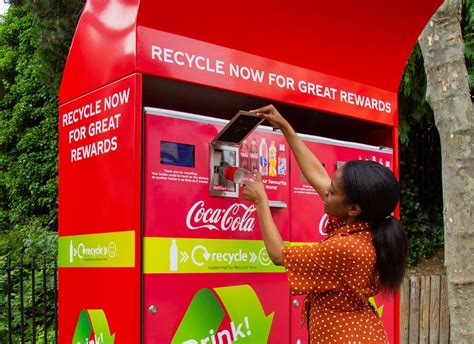
Coca-Cola is piloting a program featuring reverse vending machines that reward consumers for recycling its beverage containers, aiming to boost recycling rates and promote a circular economy. The initiative, currently being tested in several global markets, incentivizes consumers with rewards such as discounts and loyalty points in exchange for returning empty Coca-Cola bottles and cans.
The beverage giant has rolled out these reverse vending machines as part of its broader sustainability strategy, “World Without Waste,” which commits the company to collecting and recycling the equivalent of every bottle or can it sells globally by 2030. The machines are designed to accept various types of Coca-Cola packaging, including plastic bottles, aluminum cans, and glass bottles, streamlining the recycling process for consumers and ensuring that materials are properly sorted and processed.
“We want to make recycling as easy and rewarding as possible for people,” said a Coca-Cola spokesperson. “These reverse vending machines are a tangible way to encourage recycling and help us achieve our World Without Waste goals.”
The reverse vending machine program is being implemented in select locations across Europe, Asia, and Latin America. The exact rewards and incentives vary by region, with some markets offering discounts on future Coca-Cola purchases, while others provide points that can be redeemed for various goods and services through loyalty programs.
The effectiveness of the program will be closely monitored to assess its impact on recycling rates and consumer behavior. Coca-Cola plans to use the data collected to refine its approach and potentially expand the program to additional markets in the future. The company is also collaborating with local governments and recycling organizations to ensure that the materials collected through the reverse vending machines are properly processed and reused.
Expanding the Initiative and its Global Context
Coca-Cola’s deployment of reverse vending machines signifies a substantial move in the company’s environmental stewardship efforts and marks a step towards integrating circular economy principles into its business model. The reverse vending machine program is not just a standalone project; it is part of a broader, multifaceted strategy that includes reducing packaging waste, innovating sustainable packaging solutions, and partnering with various stakeholders to improve recycling infrastructure globally.
The global context of this initiative is critical. Plastic pollution and waste management are pressing environmental issues, with millions of tons of plastic ending up in oceans and landfills each year. The beverage industry, including Coca-Cola, has faced increasing scrutiny for its contribution to plastic waste. In response, Coca-Cola has set ambitious targets for recycling and waste reduction. The “World Without Waste” initiative represents a significant financial commitment to these goals, with substantial investments earmarked for infrastructure improvements, consumer education programs, and innovative recycling technologies.
The reverse vending machine program aims to directly address the challenge of low recycling rates in many countries. Traditional recycling systems often rely on consumers to sort and transport recyclable materials to collection points, which can be inconvenient and time-consuming. By placing reverse vending machines in convenient locations such as supermarkets, shopping malls, and public spaces, Coca-Cola hopes to make recycling more accessible and appealing to consumers.
Technological Aspects and Operational Mechanics
The technology behind Coca-Cola’s reverse vending machines is sophisticated and designed to ensure efficient and accurate sorting of recyclable materials. These machines typically use barcode scanners and optical sensors to identify the type of packaging being returned. This automated identification process helps to prevent contamination of recycling streams and ensures that materials are properly sorted for processing.
Once a container is inserted into the machine, it is compacted to reduce its volume, which allows the machine to hold a larger number of items before it needs to be emptied. The machines are equipped with sensors that monitor their fill levels and alert operators when they need to be serviced. This real-time monitoring helps to ensure that the machines are always operational and that recycling efforts are not disrupted.
The data collected by the reverse vending machines is also valuable for Coca-Cola and its partners. This data provides insights into recycling rates, consumer behavior, and the types of packaging that are most frequently returned. This information can be used to optimize the placement of machines, refine recycling programs, and develop more effective consumer education campaigns.
From an operational perspective, the reverse vending machine program requires significant coordination and logistics. Coca-Cola works with local recycling partners to ensure that the materials collected by the machines are transported to processing facilities and properly recycled. This involves establishing collection routes, managing inventory levels, and ensuring compliance with local regulations.
Consumer Incentives and Behavioral Impact
The success of Coca-Cola’s reverse vending machine program hinges on its ability to motivate consumers to recycle. The incentives offered by the program play a crucial role in this regard. By providing tangible rewards for recycling, Coca-Cola aims to change consumer behavior and make recycling a more habitual activity.
The types of incentives offered vary by region, but they typically include discounts on future Coca-Cola purchases, points that can be redeemed for various goods and services through loyalty programs, or even direct cash payments. The specific incentives are tailored to the local market and designed to be appealing to consumers.
For example, in some European countries, consumers may receive a small cash payment for each bottle or can they return. This “deposit refund” system has been shown to be highly effective in increasing recycling rates. In other markets, consumers may receive discounts on Coca-Cola products or points that can be used to purchase items from partner retailers.
In addition to the direct financial incentives, the reverse vending machine program also aims to appeal to consumers’ sense of environmental responsibility. By making recycling more convenient and rewarding, Coca-Cola hopes to encourage consumers to view recycling as a positive and worthwhile activity.
Challenges and Opportunities
While Coca-Cola’s reverse vending machine program holds significant promise, it also faces several challenges. One of the main challenges is the cost of deploying and maintaining the machines. Reverse vending machines are expensive to purchase, install, and operate. Coca-Cola must carefully evaluate the economics of the program to ensure that it is financially sustainable.
Another challenge is ensuring that the materials collected by the machines are properly processed and recycled. This requires a robust recycling infrastructure and effective partnerships with local recycling organizations. In some countries, the recycling infrastructure may not be adequate to handle the increased volume of materials collected by the machines.
Despite these challenges, Coca-Cola’s reverse vending machine program also presents significant opportunities. The program has the potential to significantly increase recycling rates, reduce plastic waste, and promote a circular economy. It also provides Coca-Cola with an opportunity to enhance its brand image and demonstrate its commitment to sustainability.
Furthermore, the data collected by the reverse vending machines can be used to improve recycling programs and develop more effective consumer education campaigns. This data can also be shared with other stakeholders, such as governments and recycling organizations, to help them make informed decisions about waste management policy.
Stakeholder Collaboration and Partnerships
Collaboration with various stakeholders is essential for the success of Coca-Cola’s reverse vending machine program. Coca-Cola works closely with local governments, recycling organizations, retailers, and consumers to implement and operate the program effectively.
Local governments play a crucial role in providing the regulatory framework and infrastructure support needed for the program to succeed. This includes issuing permits for the installation of machines, providing access to recycling facilities, and enforcing recycling regulations.
Recycling organizations are responsible for processing the materials collected by the machines and ensuring that they are properly recycled. Coca-Cola works with these organizations to establish collection routes, manage inventory levels, and ensure compliance with local regulations.
Retailers play a key role in providing locations for the installation of reverse vending machines. By hosting the machines in their stores, retailers can attract customers and promote recycling to their communities.
Consumers are the most important stakeholder in the program. Without their participation, the program would not be successful. Coca-Cola works to educate consumers about the benefits of recycling and to make recycling as convenient and rewarding as possible.
Long-Term Vision and Sustainability Goals
Coca-Cola’s reverse vending machine program is part of a larger, long-term vision for sustainability. The company is committed to reducing its environmental impact and promoting a circular economy.
The “World Without Waste” initiative is a key component of this vision. The initiative commits Coca-Cola to collecting and recycling the equivalent of every bottle or can it sells globally by 2030. This is an ambitious goal, but Coca-Cola believes it is achievable through a combination of strategies, including the deployment of reverse vending machines, the development of more sustainable packaging, and the promotion of recycling education programs.
Coca-Cola also recognizes the importance of addressing other environmental issues, such as climate change and water scarcity. The company has set targets for reducing its carbon emissions and improving its water efficiency.
By integrating sustainability into its core business strategy, Coca-Cola hopes to create long-term value for its shareholders, its customers, and the planet. The reverse vending machine program is just one example of how Coca-Cola is working to achieve this goal.
Future Expansion and Technological Advancements
Looking ahead, Coca-Cola plans to expand its reverse vending machine program to additional markets and to incorporate new technological advancements. The company is exploring the use of artificial intelligence (AI) and machine learning (ML) to optimize the operation of the machines and to improve the accuracy of material sorting.
AI and ML can be used to analyze data collected by the machines and to identify patterns and trends in recycling behavior. This information can be used to optimize the placement of machines, refine recycling programs, and develop more effective consumer education campaigns.
Coca-Cola is also exploring the use of blockchain technology to track the movement of recyclable materials from the point of collection to the point of processing. This would provide greater transparency and accountability in the recycling process and help to ensure that materials are properly recycled.
Furthermore, Coca-Cola is working to develop more sustainable packaging materials, such as plant-based plastics and biodegradable materials. These materials would reduce the environmental impact of Coca-Cola’s packaging and make it easier to recycle.
The Impact on the Beverage Industry
Coca-Cola’s reverse vending machine program is likely to have a significant impact on the beverage industry as a whole. The program is setting a new standard for corporate responsibility and demonstrating the potential of innovative recycling solutions.
Other beverage companies are likely to follow Coca-Cola’s lead and implement similar programs. This could lead to a significant increase in recycling rates across the industry and a reduction in plastic waste.
The program is also likely to influence government policy on waste management. Governments may be more likely to implement policies that support recycling and the circular economy if they see that companies are taking proactive steps to address the issue of plastic waste.
Coca-Cola’s Brand Reputation and Consumer Perception
The implementation of reverse vending machines and other sustainability initiatives significantly impacts Coca-Cola’s brand reputation and consumer perception. In an era where consumers are increasingly conscious of environmental issues, companies that demonstrate a commitment to sustainability are more likely to be viewed favorably.
Coca-Cola’s investment in recycling programs and sustainable packaging can enhance its brand image and attract environmentally conscious consumers. This can lead to increased brand loyalty and sales.
However, it is important for Coca-Cola to ensure that its sustainability initiatives are genuine and transparent. Consumers are quick to spot “greenwashing” – the practice of exaggerating or misrepresenting a company’s environmental credentials.
By being transparent about its sustainability efforts and by demonstrating a genuine commitment to reducing its environmental impact, Coca-Cola can build trust with consumers and enhance its brand reputation.
The Role of Public Awareness and Education
Public awareness and education are crucial for the success of any recycling program. Coca-Cola recognizes the importance of educating consumers about the benefits of recycling and how to properly dispose of recyclable materials.
The company is investing in a range of public awareness campaigns to promote recycling and to encourage consumers to participate in the reverse vending machine program. These campaigns include television commercials, social media posts, and educational materials distributed in schools and communities.
Coca-Cola is also working with local governments and recycling organizations to develop and implement recycling education programs. These programs aim to educate consumers about the importance of recycling and to provide them with the information they need to recycle properly.
By raising public awareness and promoting recycling education, Coca-Cola hopes to create a culture of recycling and to encourage more people to participate in recycling programs.
Economic Benefits and Job Creation
The circular economy model, which Coca-Cola’s reverse vending machine program supports, has significant economic benefits and the potential to create jobs. By recycling materials and reusing them in new products, companies can reduce their reliance on virgin resources and lower their production costs.
The recycling industry itself is a significant employer, providing jobs in collection, sorting, processing, and manufacturing. As recycling rates increase, the industry is likely to grow, creating even more job opportunities.
Coca-Cola’s investment in recycling programs and sustainable packaging can contribute to the growth of the circular economy and the creation of new jobs. This can have a positive impact on local communities and the overall economy.
Addressing Criticism and Concerns
Despite its efforts to promote sustainability, Coca-Cola has faced criticism from environmental groups and activists. Some critics argue that the company’s recycling programs are not sufficient to offset the environmental impact of its products. Others argue that Coca-Cola should focus on reducing its use of plastic packaging altogether.
Coca-Cola acknowledges these concerns and is taking steps to address them. The company is investing in the development of more sustainable packaging materials and is working to reduce its overall use of plastic.
Coca-Cola also recognizes that its recycling programs are not perfect and that there is always room for improvement. The company is committed to continuously evaluating and refining its programs to ensure that they are as effective as possible.
By being responsive to criticism and by continuously striving to improve its sustainability performance, Coca-Cola hopes to build trust with stakeholders and demonstrate its commitment to environmental responsibility.
Conclusion: A Step in the Right Direction
Coca-Cola’s reverse vending machine program represents a significant step in the right direction towards promoting recycling and reducing plastic waste. While challenges remain, the program demonstrates the potential of innovative solutions to address pressing environmental issues. By combining technological advancements, consumer incentives, and stakeholder collaboration, Coca-Cola is setting a new standard for corporate responsibility in the beverage industry. The success of this initiative will not only depend on Coca-Cola’s efforts but also on the collective commitment of consumers, governments, and other stakeholders to embrace a circular economy and build a more sustainable future.
The program, while ambitious, is just one piece of the puzzle in addressing the global waste crisis. Continued innovation, collaboration, and a fundamental shift in consumer behavior are essential to achieving meaningful and lasting change. Coca-Cola’s commitment to its “World Without Waste” initiative and its ongoing efforts to improve its sustainability performance are crucial steps in this direction, setting a precedent for other companies to follow and contributing to a more sustainable future for all.
Frequently Asked Questions (FAQ)
1. What exactly are Coca-Cola’s reverse vending machines?
Coca-Cola’s reverse vending machines are automated systems that reward consumers for recycling empty Coca-Cola beverage containers, such as plastic bottles, aluminum cans, and glass bottles. The machines use barcode scanners and optical sensors to identify the type of packaging and provide incentives like discounts or loyalty points upon successful return. These machines are part of Coca-Cola’s “World Without Waste” initiative, aimed at collecting and recycling the equivalent of every bottle or can the company sells globally by 2030.
2. How do the incentives work for recycling with these machines?
The incentives vary by region and market. Some areas offer discounts on future Coca-Cola purchases, while others provide points that can be redeemed for various goods and services through loyalty programs. In some European countries, consumers may receive a small cash payment for each returned container, operating as a “deposit refund” system. The specific rewards are tailored to appeal to local consumers and make recycling more attractive.
3. Where are these reverse vending machines currently located?
The reverse vending machine program is being piloted in select locations across Europe, Asia, and Latin America. These machines are typically placed in high-traffic areas such as supermarkets, shopping malls, and public spaces to maximize accessibility and encourage consumer participation. Coca-Cola strategically selects these locations to make recycling as convenient as possible.
4. How does Coca-Cola ensure that the collected materials are actually recycled?
Coca-Cola collaborates with local recycling partners and organizations to ensure that the materials collected by the reverse vending machines are properly processed and recycled. This involves establishing efficient collection routes, managing inventory levels, and ensuring compliance with local recycling regulations. The company also employs data analytics to track recycling rates and optimize the program’s effectiveness.
5. What is Coca-Cola’s “World Without Waste” initiative, and how do these machines fit into it?
The “World Without Waste” initiative is Coca-Cola’s comprehensive sustainability strategy that commits the company to collecting and recycling the equivalent of every bottle or can it sells globally by 2030. The reverse vending machines are a key component of this initiative, serving as a tangible way to encourage recycling, reduce waste, and promote a circular economy. Other aspects of the initiative include developing more sustainable packaging, reducing packaging waste, and partnering with stakeholders to improve recycling infrastructure worldwide.









